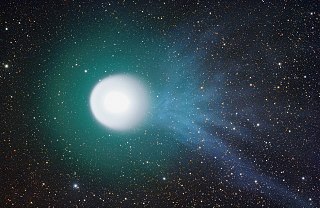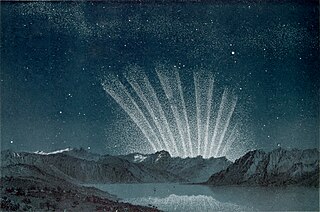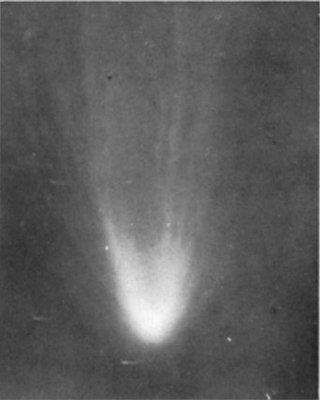Related Research Articles

Comet Ikeya–Seki, formally designated C/1965 S1, 1965 VIII, and 1965f, was a long-period comet discovered independently by Kaoru Ikeya and Tsutomu Seki. First observed as a faint telescopic object on September 18, 1965, the first calculations of its orbit suggested that on October 21, it would pass just 450,000 km (280,000 mi) above the Sun's surface, and would probably become extremely bright.
Comet White–Ortiz–Bolelli was a bright comet which appeared in 1970. It was a member of the Kreutz sungrazers, a family of comets which resulted from the break-up of a large parent comet several centuries ago. It was already easily visible to the naked eye when first discovered, and reached a maximum apparent magnitude of +1.

Comet Pojmański is a non-periodic comet discovered by Grzegorz Pojmański on January 2, 2006, and formally designated C/2006 A1. Pojmański discovered the comet at Warsaw University Astronomic Observatory using the Las Campanas Observatory in Chile as part of the All Sky Automated Survey (ASAS). Kazimieras Cernis at the Institute of Theoretical Physics and Astronomy at Vilnius, Lithuania, located it the same night and before the announcement of Pojmański's discovery, in ultraviolet images taken a few days earlier by the SWAN instrument aboard the SOHO satellite. A pre-discovery picture was later found from December 29, 2005.

13P/Olbers is a periodic comet with an orbital period of 69 years. It fits the classical definition of a Halley-type comet with a period between 20 and 200 years. The comet last passed perihelion 30 June 2024 and it was previously seen in 1956. The next perihelion is in 2094.

Comet Holmes is a periodic comet in the Solar System, discovered by the British amateur astronomer Edwin Holmes on November 6, 1892. Although normally a very faint object, Holmes became notable during its October 2007 return when it temporarily brightened by a factor of a million, in what was the largest known outburst by a comet, and became visible to the naked eye. It also briefly became the largest object in the Solar System, as its coma expanded to a diameter greater than that of the Sun. Between 1857–2106 perihelion remains between 2.05–2.36 AU.
The Comet of 1729, also known as C/1729 P1 or Comet Sarabat, was an assumed parabolic comet with an absolute magnitude of −3, the brightest ever observed for a comet; it is therefore considered to be potentially the largest comet ever seen. With an assumed eccentricity of 1, it is unknown if this comet will return in a hundred thousand years or be ejected from the Solar System.

The Great Comet of 1744, whose official designation is C/1743 X1, and which is also known as Comet de Chéseaux or Comet Klinkenberg-Chéseaux, was a spectacular comet that was observed during 1743 and 1744. It was discovered independently in late November 1743 by Jan de Munck, in the second week of December by Dirk Klinkenberg, and, four days later, by Jean-Philippe de Chéseaux. It became visible with the naked eye for several months in 1744 and displayed dramatic and unusual effects in the sky. Its absolute magnitude – or intrinsic brightness – of 0.5 was the sixth highest in recorded history. Its apparent magnitude may have reached as high as −7, leading it to be classified as a Great Comet. This comet is noted especially for developing a 'fan' of six tails after reaching its perihelion.

Comet C/2010 X1 (Elenin) is an Oort cloud comet discovered by Russian amateur astronomer Leonid Elenin on December 10, 2010, through remote control of the International Scientific Optical Network's robotic observatory near Mayhill in the U.S. state of New Mexico. The discovery was made using the automated asteroids discovery program CoLiTec. At the time of discovery, the comet had an apparent magnitude of 19.5, which made it about 150,000 times fainter than can be seen with the naked eye. The discoverer, Leonid Elenin, originally estimated that the comet nucleus was 3–4 km in diameter, but more recent estimates place the pre-breakup size of the comet at 2 km. Comet Elenin started disintegrating in August 2011, and as of mid-October 2011 was not visible even using large ground-based telescopes.

The Great Comet of 1901, sometimes known as Comet Viscara, formally designated C/1901 G1, was a comet which became bright in the spring of 1901. Visible exclusively from the southern hemisphere, it was discovered on the morning of April 12, 1901 as a naked-eye object of second magnitude with a short tail. On the day of perihelion passage, the comet's head was reported as deep yellowish in color, trailing a 10-degree tail. It was last seen by the naked eye on May 23.

Comet ISON, formally known as C/2012 S1, was a sungrazing comet from the Oort cloud which was discovered on 21 September 2012 by Vitaly Nevsky and Artyom Novichonok.

Comet Beljawsky, formally designated as C/1911 S3, is a comet discovered by the Russian astronomer Sergei Ivanovich Beljawsky on September 29, 1911 and shortly thereafter, it was seen independently by four or five other observers in the United States and probably by others throughout the world. At the time it was discovered, the comet was near to the Sun which made observations difficult. However, several days after discovery it was a naked-eye object for a few days in the morning sky and later, after perihelion, as an evening object. It faded rapidly, becoming visible only in telescopes and was last seen on February 17, 1912. The comet sported a tail 8 to 10 degrees in length. In mid-October, the comet was visible in the evening sky together with another bright comet, C/1911 O1 (Brooks).

C/2014 E2 (Jacques), provisionally designated as S002692, is a long-period comet discovered by the Brazilian astronomers Cristóvão Jacques Lage de Faria, Eduardo Pimentel, João Ribeiro de Barros and Marcelo Dias on the night of 13 March 2014. It was the second comet discovered by the SONEAR Observatory team after comet C/2014 A4.

C/1874 H1 (Coggia) is a non-periodic comet, which in the summer of 1874 could be seen by the naked eye. On the basis of its brightness, the comet has been called the Great Comet of 1874; on July 13 of that year its apparent magnitude peaked at between 0 and 1.
C/1865 B1 was a non-periodic comet, which in 1865 was so bright that it was visible to unaided-eye observations in the Southern Hemisphere. The comet could not be seen from the Northern Hemisphere.

C/2019 Y4 (ATLAS) was a comet with a near-parabolic orbit discovered by the ATLAS survey on December 28, 2019. Early predictions based on the brightening rate suggested that the comet could become as bright as magnitude 0 matching the brightness of Vega. It received widespread media coverage due to its dramatic increase in brightness and orbit similar to the Great Comet of 1844, but on March 22, 2020, the comet started disintegrating. Such fragmentation events are very common for Kreutz Sungrazers. The comet continues to fade and did not reach naked eye visibility. By mid-May, comet ATLAS appeared very diffuse even in a telescope. C/2019 Y4 (ATLAS) has not been seen since May 21, 2020.

C/2020 F3 (NEOWISE) or Comet NEOWISE is a long period comet with a near-parabolic orbit discovered on March 27, 2020, by astronomers during the NEOWISE mission of the Wide-field Infrared Survey Explorer (WISE) space telescope. At that time, it was an 18th-magnitude object, located 2 AU away from the Sun and 1.7 AU away from Earth.

C/2021 A1 (Leonard) was a long period comet that was discovered by G. J. Leonard at the Mount Lemmon Observatory on 3 January 2021 when the comet was 5 AU (750 million km) from the Sun. It had a retrograde orbit. The nucleus was about 1 km across. It came within 4 million km (2.5 million mi) of Venus, the closest-known cometary approach to Venus.

C/2014 UN271 (Bernardinelli–Bernstein), simply known as C/2014 UN271 or Comet Bernardinelli–Bernstein (nicknamed BB), is a large Oort cloud comet discovered by astronomers Pedro Bernardinelli and Gary Bernstein in archival images from the Dark Energy Survey. When first imaged in October 2014, the object was 29 AU (4.3 billion km; 2.7 billion mi) from the Sun, almost as far as Neptune's orbit and the greatest distance at which a comet has been discovered. With a nucleus diameter of at least 120 km (75 mi), it is the largest Oort cloud comet known. It is approaching the Sun and will reach its perihelion of 10.9 AU (just outside of Saturn's orbit) in January 2031. It will not be visible to the naked eye because it will not enter the inner Solar System.

C/2022 E3 (ZTF) is a non-periodic comet from the Oort cloud that was discovered by the Zwicky Transient Facility (ZTF) on 2 March 2022. The comet has a bright green glow around its nucleus, due to the effect of sunlight on diatomic carbon and cyanogen. The comet's systematic designation starts with C to indicate that it is not a periodic comet, and "2022 E3" means that it was the third comet to be discovered in the first half of March 2022.

C/2023 A3 (Tsuchinshan–ATLAS) is a comet from the Oort cloud discovered by the Purple Mountain Observatory in China on 9 January 2023 and independently found by ATLAS South Africa on 22 February 2023. The comet passed perihelion at a distance of 0.39 AU on 27 September 2024, when it became visible to the naked eye. Tsuchinshan-ATLAS peaked its brightest magnitude shortly after passing the Sun at 9 October, with a magnitude of −4.9 per reported observations at the Comet Observation Database (COBS).
References
- 1 2 J. Herapath (1831). "Comet seen, January 7, 1831". Monthly Notices of the Royal Astronomical Society. 2: 6–7. Bibcode:1831MNRAS...2....6H.
- 1 2 3 4 R. C. Kapoor (2011). "Madras Observatory and the Discovery of C/1831 A1 (The Great Comet of 1831)". Journal of Astronomical History and Heritage. 14 (2): 93–102. Bibcode:2011JAHH...14...93K. doi: 10.3724/SP.J.1440-2807.2011.02.02 . ISSN 1440-2807.
- ↑ "Comet Names and Designations". International Comet Quarterly. Retrieved 16 November 2024.
- 1 2 "C/1831 A1 – JPL Small-Body Database Browser". ssd.jpl.nasa.gov. Jet Propulsion Laboratory . Retrieved 16 November 2024.
- 1 2 G. W. Kronk (2003). "C/1831 A1 (Great comet)". Cometography: A Catalog of Comets. Vol. 2: 1800–1899. Cambridge University Press. pp. 95–96. ISBN 0521585058.
- 1 2 3 J. E. Bortle (1998). "The Bright Comet Chronicles". International Comet Quarterly. Retrieved 16 November 2024.

